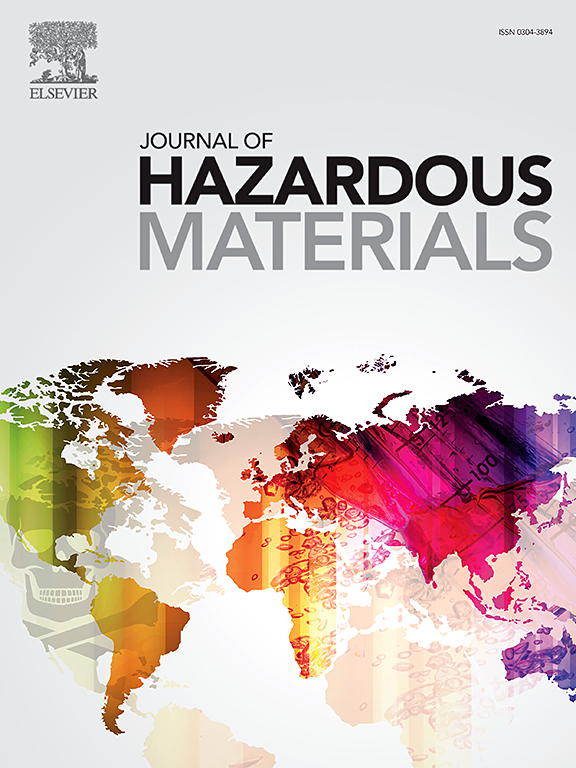STING抑制通过cGAS-STING信号通路抑制丁氯气诱导的脾巨噬细胞焦亡和M1极化
IF 11.3
1区 环境科学与生态学
Q1 ENGINEERING, ENVIRONMENTAL
引用次数: 0
摘要
丁草胺(BTR)是一种全球普遍使用的酰胺类除草剂,由于其生物蓄积潜力和在哺乳动物系统中的慢性毒性,造成了重大的环境健康风险。鉴于脾脏在协调全身免疫稳态中的关键作用,本研究研究了btr诱导的ICR小鼠在28天亚急性暴露(10 mg/kg)后的免疫病理机制。组织病理学检查显示脾脏边缘区结构明显紊乱,同时伴有超微结构线粒体异常和线粒体膜电位降低(ΔΨm)。线粒体通透性过渡开孔触发线粒体DNA (mtDNA)的细胞质易位,激活干扰素基因刺激因子(STING)通路——先天免疫的主要调节因子。STING激活启动了分叉的下游信号,TBK1磷酸化和随后的IRF3 / NF-κB核易位证明了这一点。这种双信号级联同时通过Gasdermin d依赖性焦亡(裂解GSDMD-NT)导致免疫原性细胞死亡,并驱动巨噬细胞极化(IFN-α / β, IL-1β, TNF-α)。至关重要的是,C-176对STING的药理学抑制减轻了焦亡(GSDMD切割减少)和炎症细胞因子的激增。我们的研究结果不仅率先确定了mtDNA-STING轴是btr诱导的脾免疫毒性的核心机制,而且验证了STING失活是一种减轻除草剂相关免疫功能障碍的靶向策略。这项工作为环境毒物风险评估和免疫调节提供了重要的见解。本文章由计算机程序翻译,如有差异,请以英文原文为准。

STING inhibition suppresses butachlor-induced splenic macrophage pyroptosis and M1 polarization via cGAS-STING signaling
Butachlor (BTR), a globally prevalent amide herbicide, poses significant environmental health risks due to its bioaccumulation potential and documented chronic toxicity in mammalian systems. Given the spleen's pivotal role in orchestrating systemic immune homeostasis, this study investigated BTR-induced immunopathological mechanisms in ICR mice following 28-day subacute exposure (10 mg/kg). Histopathological examination revealed significant disorganization of the splenic marginal zone architecture, concomitant with ultrastructural mitochondrial abnormalities and a reduction in mitochondrial membrane potential (ΔΨm). Mitochondrial permeability transition pore opening triggered cytoplasmic translocation of mitochondrial DNA (mtDNA), activating the stimulator of interferon genes (STING) pathway—a master regulator of innate immunity. STING activation initiated bifurcated downstream signaling, evidenced by TBK1 phosphorylation and subsequent IRF3 / NF-κB nuclear translocation. This dual signaling cascade simultaneously executed immunogenic cell death via Gasdermin D-dependent pyroptosis (cleaved GSDMD-NT) and drove macrophage polarization (IFN-α / β, IL-1β, TNF-α). Crucially, pharmacological STING inhibition with C-176 attenuated both pyroptosis (GSDMD cleavage reduced) and inflammatory cytokine surge. Our findings not only pioneer the identification of the mtDNA-STING axis as the central mechanism underlying BTR-induced splenic immunotoxicity but also validate STING inactivation as a targeted strategy to mitigate herbicide-associated immune dysfunction. This work provides critical insights for environmental toxicant risk assessment and immunomodulatory.
求助全文
通过发布文献求助,成功后即可免费获取论文全文。
去求助
来源期刊

Journal of Hazardous Materials
工程技术-工程:环境
CiteScore
25.40
自引率
5.90%
发文量
3059
审稿时长
58 days
期刊介绍:
The Journal of Hazardous Materials serves as a global platform for promoting cutting-edge research in the field of Environmental Science and Engineering. Our publication features a wide range of articles, including full-length research papers, review articles, and perspectives, with the aim of enhancing our understanding of the dangers and risks associated with various materials concerning public health and the environment. It is important to note that the term "environmental contaminants" refers specifically to substances that pose hazardous effects through contamination, while excluding those that do not have such impacts on the environment or human health. Moreover, we emphasize the distinction between wastes and hazardous materials in order to provide further clarity on the scope of the journal. We have a keen interest in exploring specific compounds and microbial agents that have adverse effects on the environment.
 求助内容:
求助内容: 应助结果提醒方式:
应助结果提醒方式:


